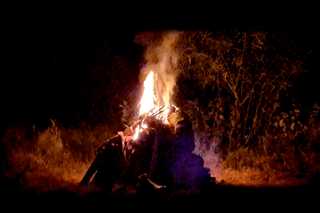
Forced Cremation of Dalit Rape Victim in Delhi Highlights Pattern of State’s Complicity in Caste‑Based Crimes
“The family was intimidated by the police… the police repeatedly questioned and harassed them,” a resident said in a report.

The alleged rape and murder of a nine-year-old Dalit girl from Delhi on Sunday has sent shockwaves through the country.
A Newslaundry report begins with a disturbing recollection: “Don’t shout. Don’t scream. What had to happen has happened,” the girl’s mother was told by the crematorium priest, one of the accused in the crime. “And then he set my child on fire,” she said.
The child had gone out to fill water from a nearby crematorium. When she didn’t return, her mother went to the crematorium and found her lifeless body there. The priest alleged that the girl was electrocuted while filling water from the cooler and insisted on cremating her instead of calling the police.
The girl’s body had burn marks on her wrists and elbow, and there was blood coming from her nose, the mother said. So far, four suspects, including a priest, have been arrested in connection with the case. But due to the rushed cremation, the only forensic evidence that remains is ashes and parts of the girl’s legs.
Allegedly, the police also refused to douse the funeral pyre flames. “I asked them, ‘Why are you not trying to stop the fire? How will you collect evidence?’ They didn’t do anything. When I tried to pour a bucket of water to prevent the body from burning, one policeman caught my hand and told me not to do that,” two witnesses told Newslaundry.
Moreover, the police allegedly resisted appeals to add a rape charge against the accused. “Instead of going after the accused, the police kept questioning us… They separated us and there were multiple rounds of questioning, followed by intimidation to remove the rape charge,” the girl’s father told The Print.
The incident speaks to an emerging pattern in caste-based sexual violence, wherein crucial evidence that could implicate the perpetrators is destroyed through forcibly cremating the victim’s body— usually without the family’s consent. “Killing the victim, or burning her body, has been used more often than not by dominant caste rapists to either silence the voice of the victim or destroy any evidence that can tie them to the crime,” the National Council for Women Leaders noted.
In a long list of hurdles that Dalit women specifically face while reporting sexual violence, the biggest is these forced cremations of victims who are murdered even before any charges are filed. Indeed, “cremation” is a tactic here for destroying evidence.
This strategy is endorsed both explicitly and tacitly by the state, as was seen in the Hathras incident in December 2020 where the police themselves carried out the cremation and in this one where they allegedly didn’t do anything to stop the same.
Related on The Swaddle:
The Dalit Caste Identity of Hathras Victim Is Vital to Recognizing Her Rape as a Casteist Crime
There are indeed chilling parallels between the Hathras crime and the present one. In both, the victims’ bodies were cremated without giving their families a chance to take them home and perform the last rites. In both, the police were involved in the hasty cremation process without the families’ consent. In both, the families were subject to long police interrogations regarding a crime committed against their child. And in both, the perpetrators were oppressor caste men who allegedly raped and murdered an oppressed caste woman/girl.
These similarities are no coincidence. Many activists have pointed out how the impunity with which this tactic was used in Hathras may have fuelled the perpetrators to do the same now.
The state’s participation in the process arguably perpetuates oppressor caste impunity and also represents oppressor caste solidarity in obstructing justice. It may even represent the state’s complicity in keeping oppressor caste hegemony intact, through the brutalization of Dalit women and girls’ bodies.
Rape and sexual violence have long been weaponized against Dalit women in India to “show them their place.” While the conviction rate for rape, in general, is 25%, this number drops to 2% for Dalit women.
With forced cremations becoming a norm, this number is likely to decrease further for two reasons. One, the strategy destroys the most conclusive evidence of rape; two, it leaves the case hingeing on the word of the Dalit victim’s family members against oppressor caste perpetrators, further skewing the power dynamic in favor of the oppressor caste perpetrators. This is of particular relevance, in a scenario in which most of the rape cases declared “false” by the police involve Scheduled Caste victims.
Further, oppressed caste women have to grapple with bias at every stage of the process if they do report their cases, as outlined by a Human Rights Watch report on impunity against Dalit women.
“People think rape is a single crime. But for Dalit rape victims, it’s just the beginning of a lifelong chain of crimes and struggles: mental abuse, fear, intimidation, threats, denial of basic rights, denial of education and a decent livelihood — the list is very long,” Manisha Mashaal, founder of Swabhiman Society and a Dalit women’s rights defender, told Equality Now.
Rohitha Naraharisetty is a Senior Associate Editor at The Swaddle. She writes about the intersection of gender, caste, social movements, and pop culture. She can be found on Instagram at @rohitha_97 or on Twitter at @romimacaronii.
Related


More Than 3,000 Nurses in Kolkata Protest Pay Inequality
